Related Research Articles
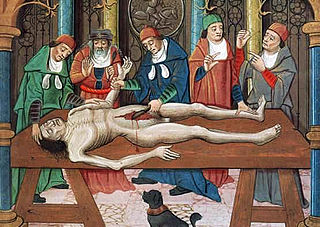
The history of anatomy spans from the earliest examinations of sacrificial victims to the advanced studies of the human body conducted by modern scientists. Written descriptions of human organs and parts can be traced back thousands of years to ancient Egyptian papyri, where attention to the body was necessitated by their highly elaborate burial practices.

Thomas Jefferson University is a private research university in Philadelphia, Pennsylvania. Established in its earliest form in 1824, the university officially combined with Philadelphia University in 2017. The university is named for U.S. Founding Father and president Thomas Jefferson. It is classified among "R2: Doctoral Universities – High research activity".

The history of anatomy in the 19th century saw anatomists largely finalise and systematise the descriptive human anatomy of the previous century. The discipline also progressed to establish growing sources of knowledge in histology and developmental biology, not only of humans but also of animals.
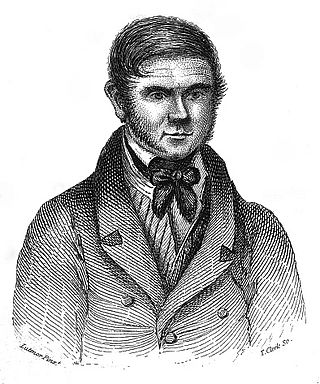
The Burke and Hare murders were a series of sixteen murders committed over a period of about ten months in 1828 in Edinburgh, Scotland. They were undertaken by William Burke and William Hare, who sold the corpses to Robert Knox for dissection at his anatomy lectures.

Dissection is the dismembering of the body of a deceased animal or plant to study its anatomical structure. Autopsy is used in pathology and forensic medicine to determine the cause of death in humans. Less extensive dissection of plants and smaller animals preserved in a formaldehyde solution is typically carried out or demonstrated in biology and natural science classes in middle school and high school, while extensive dissections of cadavers of adults and children, both fresh and preserved are carried out by medical students in medical schools as a part of the teaching in subjects such as anatomy, pathology and forensic medicine. Consequently, dissection is typically conducted in a morgue or in an anatomy lab.

Body snatching is the illicit removal of corpses from graves, morgues, and other burial sites. Body snatching is distinct from the act of grave robbery as grave robbing does not explicitly involve the removal of the corpse, but rather theft from the burial site itself. The term 'body snatching' most commonly refers to the removal and sale of corpses primarily for the purpose of dissection or anatomy lectures in medical schools. The term was coined primarily in regard to cases in the United Kingdom and United States throughout the 17th, 18th, and 19th centuries. However, there have been cases of body snatching in many countries, with the first recorded case dating back to 1319 in Bologna, Italy.

Grave robbery, tomb robbing, or tomb raiding is the act of uncovering a grave, tomb or crypt to steal commodities. It is usually perpetrated to take and profit from valuable artefacts or personal property. A related act is body snatching, a term denoting the contested or unlawful taking of a body, which can be extended to the unlawful taking of organs alone.
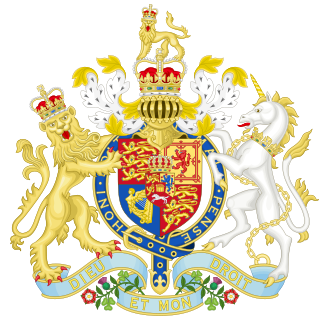
The Anatomy Act 1832, also known as the Warburton Anatomy Act 1832 is an act of Parliament of the United Kingdom that gave free licence to doctors, teachers of anatomy and bona fide medical students to dissect donated bodies. It was enacted in response to public revulsion at the illegal trade in corpses.
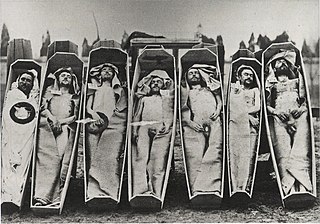
A cadaver, often known as a corpse, is a dead human body. Cadavers are used by medical students, physicians and other scientists to study anatomy, identify disease sites, determine causes of death, and provide tissue to repair a defect in a living human being. Students in medical school study and dissect cadavers as a part of their education. Others who study cadavers include archaeologists and arts students. In addition, a cadaver may be used in the development and evaluation of surgical instruments.
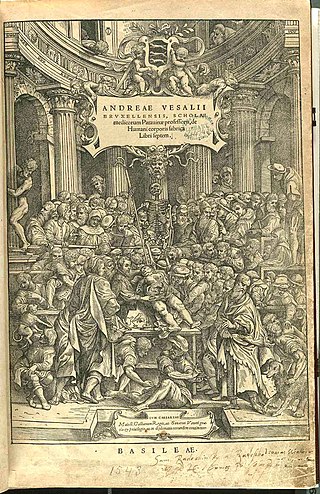
The Medical Renaissance, from around 1400 to 1700 CE, was a period of progress in European medical knowledge, with renewed interest in the ideas of the ancient Greek, Roman civilizations and Islamic medicine, following the translation into Medieval Latin of many works from these societies. Medical discoveries during the Medical Renaissance are credited with paving the way for modern medicine.

Pandit Madhusudan Gupta was a Bengali Baidya Brahmin translator and Ayurvedic practitioner who was also trained in Western medicine and is credited with having performed India's first human dissection at Calcutta Medical College (CMC) in 1836, almost 3,000 years after Susruta.
Night Doctors are bogeymen of African American folklore, resulting from some factual basis.
An anatomy murder is a murder committed in order to use all or part of the cadaver for medical research or teaching. It is not a medicine murder because the body parts are not believed to have any medicinal use in themselves. The motive for the murder is created by the demand for cadavers for dissection, and the opportunity to learn anatomy and physiology as a result of the dissection. Rumors concerning the prevalence of anatomy murders are associated with the rise in demand for cadavers in research and teaching produced by the Scientific Revolution. During the 19th century, the sensational serial murders associated with Burke and Hare and the London Burkers led to legislation which provided scientists and medical schools with legal ways of obtaining cadavers. Rumors persist that anatomy murders are carried out wherever there is a high demand for cadavers. These rumors, like those concerning organ theft, are hard to substantiate, and may reflect continued, deep-held fears of the use of cadavers as commodities.
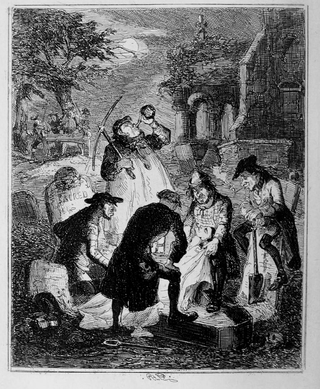
Resurrectionists were body snatchers who were commonly employed by anatomists in the United Kingdom during the 18th and 19th centuries to exhume the bodies of the recently dead. Between 1506 and 1752 only a very few cadavers were available each year for anatomical research. The supply was increased when, in an attempt to intensify the deterrent effect of the death penalty, Parliament passed the Murder Act 1752. By allowing judges to substitute the public display of executed criminals with dissection, the new law significantly increased the number of bodies anatomists could legally access. This proved insufficient to meet the needs of the hospitals and teaching centres that opened during the 18th century. Corpses and their component parts became a commodity, but although the practice of disinterment was hated by the general public, bodies were not legally anyone's property. The resurrectionists therefore operated in a legal grey area.

Joseph Nash McDowell (1805–1868) was an American doctor primarily remembered for his grave-digging practices, where he illegally exhumed corpses in order to study human anatomy. He is also known for his influence on Mark Twain, and was likely the inspiration for Twain's fictional character Dr. Robinson in "The Adventures of Tom Sawyer."
As anatomy classes in medical education proliferated in the 19th century, so too did the need for bodies to dissect. Grave robbery proliferated, along with associated social discontent, revulsion, and unhappiness. Conflicts arose between medical practitioners and defenders of bodies, graves and graveyards. This resulted in riots. Social legislation was passed in many countries to address the competing concerns.
"An Act to Promote Medical Science and Protect Burial Grounds", informally known as the Bone Bill, was an 1854 bill in New York. Its purpose was to greatly increase the number of cadavers available for legal dissection in medical schools.
Lebanon Cemetery was an African-American cemetery in Philadelphia, Pennsylvania, established in 1849. It was one of only two private African-American cemeteries in Philadelphia at the time. Lebanon Cemetery was condemned in 1899. The bodies were reinterred in 1902 to Eden Cemetery in Collingdale, Pennsylvania, and the cemetery was closed in 1903.
The Winchester Medical College (WMC) building, currently located at 302 W. Boscawen Street, Winchester, Virginia, along with all its records, equipment, museum, and library, was burned on May 16, 1862, by Union troops occupying the city. This was "retaliation for the dissection of cadavers from John Brown's Raid". More specifically, it was in retaliation for the desecration they discovered of one of those cadavers, the body of one of John Brown's sons, identified years later as Watson. The body of John Brown's son, fighting against slavery in the raid on Harpers Ferry, had been dishonored: made into an anatomical specimen in the College's museum, with the label "Thus always with Abolitionists". In addition, students at the school collected and then dissected the bodies of three other members of Brown's troop and a black boy was apparently tortured and killed there for favoring the Union.
Thomas Vaughan was a bodysnatcher active in Great Yarmouth, Norfolk, in 1827. During this period, Vaughan exhumed at least 10 corpses from St. Nicholas' Churchyard and sold them to surgeons in London for dissection.
References
- ↑ The Boston Medical and Surgical Journal. Cupples, Upham & Company. 1880-01-01.
- 1 2 Scovil, Lindsay (2015). "A Market for Death" . Retrieved October 23, 2016.
- ↑ Frazier, Harriet C. (2001-01-01). Slavery and Crime in Missouri, 1773-1865. McFarland. ISBN 9780786409778.
- ↑ Oshinsky, David (2016). Bellevue: Three centuries of medicine and mayhem at America's most storied hospital. Doubleday. p. 67. ISBN 9780385523363.
- ↑ Forbes, W.S. "History of the Anatomy Act of Pennsylvania". Jefferson.
- 1 2 "Passage of an Anatomy Act in Pennsylvania: An Act for the Promotion of Medical Science, and to Prevent the Traffic in Human Bodies". Chicago Medical Examiner. 1867.
- ↑ "Anatomical Law of the State of Pennsylvania, Enacted June 13, 1883". Science. 3 (55): 84–86. 1896. Bibcode:1896Sci.....3...84.. doi: 10.1126/science.3.55.84 . JSTOR 1624701. PMID 17802054.